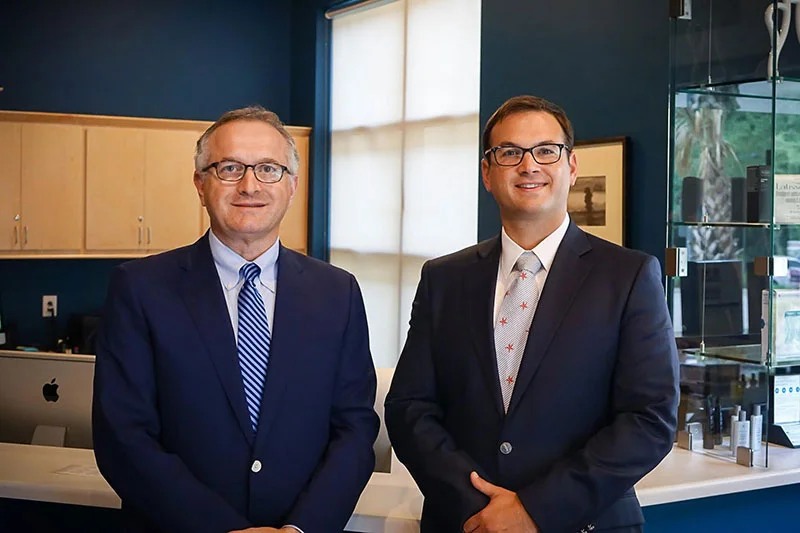Facelift
There are two major changes that occur in the face with aging. The obvious changes include loosening of the skin in the face and neck, manifesting as laxity and sagging, nasolabial folds, jowl formation, and what are referred to as “marionette lines”—creases extending downward from the corners of the mouth. The other less obvious change is a loss of volume, particularly in the cheeks. Genetics, diet, smoking, sun exposure, weight fluctuations, and the natural aging process can all contribute to these changes. The neck muscles can also loosen or splay, causing bands and folds to form under the chin and leading people to look years older than they really are.

What is a Facelift?
Facelift surgery is designed to eliminate laxity or looseness in the face and neck, thus restoring a more youthful jawline, neck, and midface volume. This tightening and repositioning of facial and neck tissue can recreate a more youthful profile and, therefore, a younger overall appearance. While maintaining a natural result, this tightening effect also has a secondary benefit of eliminating folds and wrinkles. When Dr. Craig Rowin performs facelift surgery, he always aims to produce the “un-operated” appearance of a rejuvenated, younger-looking face. He strives to place incisions that keep scars hidden, as well as to avoid the overly tight, “windswept” appearance that can sometimes follow a facelift.
Today, the effects of aging on the skin no longer need to be permanent. The appearance of youth can be restored with surgical or non-surgical procedures designed to enhance the look of facial skin. For individuals seeking long-lasting results, a surgical facelift can address many cosmetic signs of aging to achieve your desired aesthetic outcome. Damage caused by excessive sun exposure may require other treatments, such as fractional CO2 laser skin resurfacing; however, a facelift can provide significant structural facial rejuvenation customized to your unique needs.
Am I a Candidate for Facelift Surgery?
You may want to consider facelift surgery if you are bothered by signs of aging in the face and neck and you are seeking a more long-lasting solution than cosmetic injectable fillers can provide. A facelift can restore your youthful appearance by eliminating or improving:
- Loose and sagging skin
- Deep creases between the cheeks and mouth (nasolabial folds)
- Fallen or displaced fat
- Jowls
- Double chin
- Poorly defined jawline
Does Facelift Surgery Address the Entire Face?
Facelift surgery typically addresses the lower two-thirds of the face, and the neck. The area that extends from the upper cheeks to the neck generally exhibit signs of aging—such as jowling and sagging skin on the cheeks and jawline—most prominently. If you wish to address aesthetic concerns in the upper face, our practice also offers brow lift and eyelid surgery to correct a descending forehead and improve the appearance of droopy eyelids or aging eyes. Brow and eyelid surgery can be performed together, or as separate procedures.
How is Facelift Surgery Performed?
Depending on the complexity of your facelift surgery, the length of the procedure may vary but usually lasts several hours. Typically, the facelift procedure is an outpatient surgery, but a short inpatient stay may be required for some patients. General anesthesia is utilized. The particulars of a facelift vary according to each patient’s unique treatment plan, but generally, the goal of surgery is to firm, smooth out, and tighten facial skin for a more refreshed, youthful facial appearance.
During your facelift consultation, Dr. Rowin may recommend additional facial plastic surgery or skin treatments, including facial fat grafting in order to restore lost volume and/or submental (under the chin) liposuction. Other adjunctive procedures, such as fat grafting, radiofrequency microneedling, laser or IPL treatments, chemical peels, and skin conditioning, can all be excellent complements to facelift surgery and help further refine the skin’s texture and restore volume.
What is a Mini Facelift?
A mini facelift is a less extensive version of the standard facelift designed for patients who have milder signs of sagging skin and/or facial aging. A mini facelift can allow younger patients with early signs of skin laxity to enhance their appearance with more subtle results. The procedure can help redefine and tighten the jawline and/or minimize marionette lines and other facial creases. In general, a mini facelift can benefit individuals who only have minor skin laxity and/or early signs of jowling.
Dr. Rowin will make sure you understand the limitations of a mini facelift if you are interested in this technique. The improvement achieved is generally confined to the lower face and a mini facelift does not usually address the deeper planes of facial musculature. Since there is less need to reposition the deeper facial tissues, a mini facelift typically results in a shorter scar and a relatively faster recovery period than a standard facelift.
What is Recovery from a Facelift Like?
Following surgery, patients may experience some bruising or swelling; these reactions are to be expected and typically diminish as your recovery progresses. Discomfort can often be managed with prescribed pain medication. Bandages are worn on the face to facilitate healing for 48 hours after the procedure, and you may also be advised to keep your head elevated during this time. Plenty of rest is essential during your healing period. In general, patients typically return to their daily routines within one to two weeks, although strenuous activity and aerobic exercise should be abstained from until you receive confirmation from our surgeon, usually about four weeks.
How Long Does a Facelift Last?
Facelift surgery can typically provide exceptional results for 10 to 15 years, with the rejuvenative effects often lasting longer for some individuals. The lifespan of the results generally depends on a patient’s lifestyle habits, skin tissue elasticity, skin care regimen, age, and genetics, among other factors. However, as the aging process continues, a more youthful appearance can be maintained with a program that may include a variety of non-surgical procedures and touch-up treatments to help preserve the look of youth.
After the facelift procedure, patients typically report satisfaction from the surgery’s ability to tighten sagging facial skin and lax musculature. Depending on your treatment plan, the noticeable reduction in wrinkles, creases, jowling, and excess skin and fat generally results in a renewed, youthful aesthetic that looks natural.
Will There Be Noticeable Scarring After a Facelift?
BBecause Dr. Rowin strategically places incisions within the hairline or behind the ear, any residual scarring is typically hidden by an individual’s hair. As the healing process progresses, most patients notice substantial fading in any existing scars to the extent that they are virtually undetectable.
How Much Does a Facelift Cost?
At Plastic Surgery of the Carolinas, the price of facelift surgery is calculated on a patient-by-patient basis, as every individual has different needs and cosmetic goals. Your cost estimate will depend on the techniques employed during surgery, the extent of your aesthetic concerns, and the inclusion of any complementary procedures. Nationally, the average surgical fee for a facelift also varies by geographic location, as well as by the expertise of your plastic surgeon. After your consultation, our office will be able to provide you with a personalized quote and complete price breakdown of your facelift expenses based on the details of your treatment plan.
If you are interested in paying for a facelift over time rather than in a lump sum, our practice works with CareCredit® to make the cost of surgery more affordable. Through this premier healthcare lending company, qualified applicants can choose from a range of payment plans with low monthly installments to find the most ideal option for their budgetary concerns. If you have any questions about financing your cosmetic treatment, please call our office to speak to a friendly member of our team.
How to Choose the Best Facelift Surgeon

Once you have decided to pursue facelift surgery, selecting the most qualified plastic surgeon to make your aesthetic goals a reality can mean the difference between a natural-looking outcome and substandard results. While choosing the best facelift surgeon for your unique needs may seem daunting, the following tips can help you narrow your search:
- Choose a board-certified plastic surgeon. Although plastic surgeons are not required to maintain board-certification to practice, accreditation by the American Board of Plastic Surgery can convey a higher level of training, ongoing education, and commitment to discovering the most effective techniques within the field of plastic surgery. Simply put, completion of the rigorous educational and training requirements necessary to attain board-certification can speak volumes about a plastic surgeon’s commitment to their craft— a quality that can be pivotal to achieving the results you desire.
- Look at before-and-after photos of previous facelift patients. There is no greater indicator of your potential results than the aesthetic outcomes achieved with previous patients. Take a look at a prospective surgeon’s photo gallery to glean an idea of their past work, and determine whether the results align with your cosmetic goals.
- Read online patient reviews. In addition to achieving your aesthetic ideal, unmatched patient satisfaction should be a top priority for your prospective surgeon. When conducting your research, explore plastic surgeon reviews from a range of different platforms (such as Google, Realself, and Facebook) to gain an idea of previous patients’ levels of overall satisfaction. Patient reviews can not only give you an understanding into the treatment process, but they can also provide valuable insight into the type of care you can expect to receive.
- Meet your prospective surgeon. Ultimately, your ability to feel comfortable and confident under your surgeon’s care is the most important factor to consider when choosing the right person to perform your facelift. Schedule a consultation to meet your potential surgeon in person, and don’t hesitate to ask them any questions you may have about their training, educational background, or how they perform a facelift. Remember, a good plastic surgeon should never pressure or intimidate you into undergoing treatment.
To learn more about selecting the right surgeon to perform your facelift, please reach out to our practice.
What are Non-Surgical Alternatives to a Facelift?
Should an individual decide against a surgical facelift, our practice offers an array of non-surgical options that can improve the look, feel, and texture of facial skin for a youthful and revitalized aesthetic. The Perfect Derma™ Peel and SilkPeel® Skin Rejuvenation treatments can effectively address oily and acne-prone skin, diminish the appearance of hyperpigmentation, and smooth wrinkles and fine lines in the face for impressive results. Cutting-edge procedures using VoluDerm™, ResurFX™, and AcuPulse™ are also popular options for improving many skin concerns and diminishing signs of aging. Additionally, BOTOX® Cosmetic, JUVÉDERM®, and other injectables offered at our practice are designed to target common areas of concern that may cause an aging appearance, such as the nasolabial folds and “smoker’s lines.” For more medical-grade treatments that can fulfill whatever your unique needs may be, please don’t hesitate to contact our practice.
Additional Facelift FAQs
How should I prepare for facelift surgery?
We usually tell patients to follow these pre-operative instructions to ensure that their facelift surgery goes as smoothly as possible:
- Stop using all forms of nicotine at least six weeks prior to the procedure.
- Avoid drinking alcohol at least a week before their facelift.
- Discontinue using over-the-counter pain relievers (i.e. aspirin and ibuprofen) at least one week before the surgery because they can impair blood clotting.
- Avoid taking vitamins and herbal supplements at least one week prior to their facelift.
- Drink plenty of water to help facilitate healing.
- About a month before surgery, we recommend cutting back on salt, processed foods, and refined carbohydrates to reduce the risk of inflammation and swelling.
How long before I can exercise again after a facelift?
Most types of workouts can be resumed approximately four weeks after your facelift, although you should wait until you receive clearance before engaging in anything strenuous. We understand the desire to get back to your normal routine as soon as possible, but overexerting yourself before the body is fully healed poses risks of delaying the healing process and prolonging the recovery period. We recommend easing yourself into exercise by starting with light activity and progressing to more demanding workouts when it’s safe to do so.
When can I wear makeup again after facelift surgery?
To avoid any risk of infection, we suggest waiting at least 10 days after surgery before applying makeup or skin care products to the face. Once you are cleared to wear makeup and skincare products again, we advise you to apply sunscreen every day and wear a hat outside when possible, as your facial skin will likely be sensitive and more prone to sunburn.
Is a facelift different for men versus women?
The techniques used during facelift surgery are generally the same for both men and women, but the anatomical differences and aesthetic conventions unique to male and female patients will inform your procedure. For example, most men undergoing facelift surgery have a relatively broader face and stronger jawline, while women tend to have a rounder facial shape with smaller features. These characteristics may affect the way your facelift is tailored to achieve a natural-looking result. Ultimately, our goal is to achieve a beautiful outcome based on your needs and walk you through what to expect during every stage of the process.
Will my face look tightly “pulled” or unnatural after facelift surgery?
When performed by a skilled, meticulous plastic surgeon with years of experience, facelift surgery can deliver youthful and natural-looking results. Our board-certified plastic surgeon carefully evaluated your skin and underlying tissues to determine the best techniques for your facelift. Our goal is to make you appear like a younger version of yourself without overdoing treatment.
How can I reduce swelling after facelift surgery?
Swelling is an expected part of healing after facelift surgery and could take several weeks to fully resolve, but you can accelerate the process by sticking to a healthy lifestyle throughout recovery. Do not smoke or drink alcohol, and try to incorporate nutritious, antioxidant-rich foods into your diet.
Do I need a neck lift with my facelift?
A neck lift can often complete the results of a facelift by eliminating sagging skin and/or musculature under the chin, as well as smoothing horizontal banding across the neck. These characteristics can sometimes create the appearance of a “turkey neck.” A neck lift can be incorporated into your facelift to rejuvenate the entire facial appearance. We will evaluate your anatomical factors to determine whether you may benefit from the combination procedure If you are more concerned with a “double chin” appearance caused by excess fat, liposuction of the neck area or KYBELLA® injections can be utilized to reduce fullness.
What are the potential risks of facelift surgery?
It is important to remember that all surgeries have risks associated with them. At Plastic Surgery of the Carolinas, we strive to lower the chances of any complications by using the latest techniques and technologies and providing detailed pre- and post-operative instructions. Although very rare, here are some possible risks of facelift surgery:
- Infection
- Excessive swelling, bruising, or bleeding
- Facial nerve injury
- Numbness
- Poor or delayed incision healing
Does insurance cover a facelift?
Since the procedure is performed for cosmetic reasons rather than medical purposes, a facelift is not usually covered by insurance companies. However, each policy differs and we encourage you to check with your provider to learn more about your benefits. If coverage isn’t possible, the financing plans offered by CareCredit® can help you manage your out-of-pocket costs. Please contact our office for any questions you may have about financing your facelift.
Facelift Articles
For more information on facelift surgery, contact Plastic Surgery of the Carolinas today!

